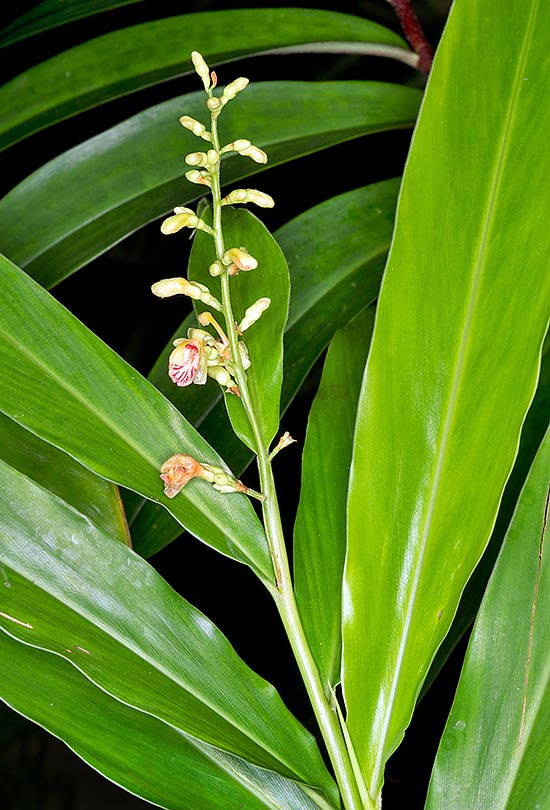Family : Zingiberaceae

Text © Pietro Puccio

English translation by Mario Beltramini

Alpinia conchigera rhizomes are aromatic and medicinal. Edible fruits © Giuseppe Mazza
The genus is honoured to the Italian physician and botanist Prospero Alpini (1553-1617); the name of the species is the combination of the Latin substantive “concha” = shell and of the verb “gero” = carry, with reference to the shape of the labellum.
Common names: lesser alpinia (English); jie bian shan jiang (Chinese); romdeng (Khmer); langkwas ranting (Malay); khaa ling (Thai); riềng rừng (Vietnamese).
The Alpinia conchigera Griff. (1851) is a perennial rhizomatous herbaceous species with thin, 0,5-1,5 m long, pseudo-stems and lanceolate leaves, 20-30 cm long and 5-10 cm broad, with pointed apex.
Terminal panicle inflorescences, 20-30 cm long carrying flowers with pale green calyx 0,3 cm long, white or pale green corolla with 0,7 cm long lobes, obovate fleshy labellum, concave, of pale yellow or white-pink colour streaked with red and curved yellow filament 0,5 cm long.
The fruits are red capsules initially globose of 0,8-1 cm of diameter, tending to become oblong, containing 3-5 very aromatic seeds.
It reproduces by division and by seed, previously kept in water for 24 hours, in organic loam with addition of sand or perlite kept humid at the temperature of 22-24 °C, with rather variable germination times, from one month onwards. Fast-growing species, it is cultivable in the zones with tropical and humid subtropical climate in full sun or slight shade on draining soils rich of organic substance, preferably acidic or neutral; cultivable also in capacious pots, in order to be sheltered during the coldest months where the climate does not allow the continuous permanence in open air.
The rhizomes are amply utilized in the origin places for aromatizing dishes and for getting an alcoholic drink and the fruits are locally consumed as vegetable.
The leaves and the rhizomes are used in the traditional medicine, in particular in the Thai one, for various pathologies due to the analgesic and anti-inflammatory properties; the essential oil gotten from the rhizomes has, furthermore, insecticidal properties.
Synonyms: Strobidia sumatrana Miq. (1861); Alpinia humilis Teijsm. & Binn. (1862); Strobidia conchigera (Griff.) Kuntze (1891); Strobidia oligosperma Kuntze (1891); Alpinia sumatrana (Miq.) K.Schum. (1899); Alpinia laosensis Gagnep. (1906); Languas sumatrana (Miq.) Merr. (1929); Languas conchigera (Griff.) Burkill (1930).
